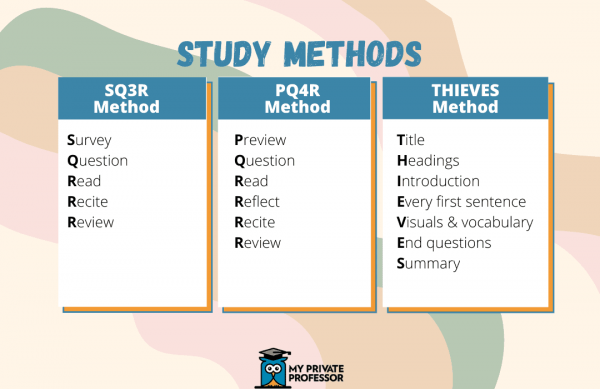Maintaining good study habits can be difficult—especially when you really would rather be doing, well, anything else. It can be frustrating to continue trying to retain information and then just finding yourself burnt out. We’ve all been there.
Maybe you’re trying to get through finals week. Or, maybe you just have an insanely big and stressful test coming up.
If your usual methods and study techniques haven’t been working for you, it’s time to change it up. Below are three study methods for improving your study game and retaining new information.
Note: these are excellent methods for when you have a lot of text or written material to cover, understand, and absorb. If you’re working from a textbook which you own, it could be beneficial to whip out your highlighter or pen to do some annotating.
SQ34 study method
This is a good study method for when you need to go through a chapter (or several) and nail down information.
Survey: Surveying includes reading/skimming over important information such as the title, introductions/summaries, bold headings, and graphics.
Question: Next, write out as many questions as you think necessary for each section. To make this easier on yourself, look at the bold headings and try to turn them into questions.
Read: Keeping your questions in mind, read the sections and try to find answers. You can also continue looking for additional questions as you go.
Recite: In between sections, see if you can answer the questions without looking at your notes. If you can’t, continue to look back at the text/your notes. Resist moving onto the next section until you can answer the questions from the current section.
Review: After finishing the chapter, go over all your questions and see if you can answer them from memory. If not, look back over your materials, then try again.
PQ4R study method
This is another great tool for reviewing text passages or sections.
Preview: Similarly to the “Survey” step in the above method, you’ll want to look over the pages you’ll be reading and take in each heading and any important dividing sections. In each section, read the first and last paragraph of each section and scan at graphics.
Question: After your preview, ask yourself questions about what you learned. Try to pinpoint the main ideas you think will come up and what you expect to learn from the sections.
Read: Read the section and take note of any key ideas.
Reflect: Afterward, reflect on what you read. This is a good time to think about how the new information fits into what you already know.
Recite: Next, discuss the material with someone else or record yourself doing it on your own. You can also write down information instead of reading it outloud, as this is still a good way to retain new knowledge.
Review: Finally, reflect on the key points in the information. Note whether or not your questions were answered and if you fully comprehend all the material.
THIEVES study method
Use the THIEVES study method to better absorb and retain text-based information.
Title: Note the title and what you know about the topic. Recognize what the topic has to do with the preceding chapter (if there is one). Think about what you expect to learn and read about in the chapter/section.
Headings: Ask whether the headings indicate the information you’ll be reading about. Think about turning the headers into questions that you can answer as you read the text.
Introduction: If there’s an intro paragraph, see if it describes what you’ll be reading about in the chapter.
Every first sentence: Thin about whether you can decipher what the chapter/section is about based on the first sentences in each paragraph.
Visuals & vocabulary: Look at any photographs, graphs, charts, maps, or other visuals. Can you learn anything from these? Read the captions to better understand the interpretations and meanings of each. Look at any vocabulary or definition lists and jot down any important words that could help you comprehend material. Note any bolded words that might be key to understanding the material.
End-of-chapter questions: Many textbooks will have questions at the end of chapters which you can use to review the information. Note the information within these questions, which will probably assist you in understanding the concepts as a whole.
Summary: Finally, reflect on everything you just learned and think about what you understand and remember—as well as what you don’t understand.
Hopefully one of the above methods can help you break through your studying rut and get going. If not, there are plenty of other ways to improve your study methods—for instance, you can try utilizing useful study apps, or you can see if office hours is for you.
If, still, nothing has worked, consider trying out an online tutoring session. With top notch tutors who work around your schedule, My Private Professor is happy to help you, in any subject, regardless of your skill level.
Author: Lydia Schapiro








